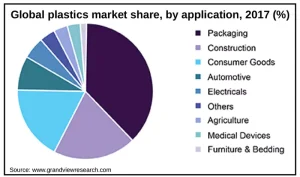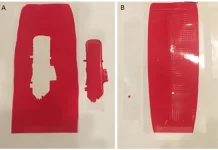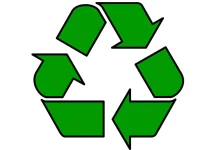By Dianna Brodine, managing editor, UV+EB Technology
 Despite a public and legislative outcry against plastics, the market outlook is strong for plastic film, flexible plastic and rigid plastic applications.
Despite a public and legislative outcry against plastics, the market outlook is strong for plastic film, flexible plastic and rigid plastic applications.
Led by increasing use in construction, automotive and electronics, “the global plastics market size was valued at USD 522.66 billion in 2017. It is poised to expand at a CAGR of 4.0% (to USD 721.14 billion) by 2025.”7 Plastic film used in packaging, plastic bags, labels, construction materials and more also is expected to grow worldwide at 3.9% CAGR over the next five years.6
Globally, packaging (both flexible and rigid formats) is the largest market for plastic resins, with construction, consumer goods and automotive following. “Demand for packaging is growing in both developed economies and in emerging markets as trends such as urbanization and rising wealth persist,” said a report from Grand View Research.3
However, the plastics industry has an image issue, and it must be mitigated for the trends in growth to continue.
The siren call of sustainability
Much like the sirens in ancient Greek tales, calls for greater sustainability are leading the plastics industry toward a crash on a rocky shore. Consumer sentiment is negative – particularly in the packaging segments. But, what the industry has is a recycling problem – not a materials problem.
“Today, over 60 countries have introduced bans and levies on the use of plastics,” said a report from IHS Markit. “Both the public and private sectors are increasing the pace of efforts to curb consumption and improve management of single-use plastics.” However, the report cautioned, “The actions are often driven by uninformed understanding of the consequences and available alternatives, or an underestimation of the ability of infrastructure to deliver.”4
There’s no doubt that the calls for increased recyclability have merit. Another IHS Markit report warned, “If overall plastics consumption continues with the same usage patterns, plastics waste in landfills and the environment will grow to over 10.5 billion metric tons by 2030.”5
Unfortunately, a significant barrier to increased plastics recycling exists – the existing technology and capacity can’t handle the volume. “Current mechanical recycling processes have scale and economics limitations, while processes such as chemical recycling are in their technology development infancy,” said IHS Markit.5
And, consumers seem to be ignoring the reasons plastics are used in many of its current industries. Alison Keane, president and CEO of the Flexible Packaging Association, explained, “Due to the environmental benefits of flexible packaging – including less water and energy usage, protection of the products with the least amount of packaging, transportation efficiency, food waste prevention, and reduced greenhouse gas emissions, among others – the industry still is growing, and we want to support that growth and not sacrifice these benefits in the rush to appease misguided public sentiment.”
That doesn’t mean those involved in the plastics industry aren’t taking action to protect the environment – and the bottom line. “While the market for flexible packaging remains very strong – currently $31.8 billion in the US – the current anti-plastic sentiment has some consumer product companies moving to other substrates, like paper,” said Keane. “It also has converters developing mono-material packaging, plastic or otherwise, so that it can be fully recycled. Converters also are working on bio-based and compostable packaging and are heavily involved with activities in the US to increase the recovery and recycling of today’s packaging, much of it flexible.”
Troy Nix, executive director of the Manufacturers Association for Plastics Processors, added, “When larger customers and OEMs – those who are supplied by these smaller processing companies – begin altering their business interest, it has a downstream ripple effect on the entire supply chain. Over just the last six months, companies like General Motors, Coke and Pepsi have realized and reacted to pressure from consumers and political organizations and have been forced to begin finding alternatives ways to do business. As a result, plastics processors are starting to look for innovative ways to aid their customers, like working to understand how to process new raw material bio-resins and other materials more friendly to the environment.”
Areas of growth
Opportunity: Medical
“A group of well over 300 manufacturers representing the US plastics processing industry and the US mold building industry identified the medical products industry as the most optimistic industry for 2020,” said Nix. “Reasons for this include the aging population, increasing life expectancy and technological developments that are cross-pollinating from different markets, such as automotive LED lighting that has made its way into operating rooms and dental offices. These drivers are increasing demand for medical devices, such as surgical implants, electro-medical equipment and sophisticated imaging systems.”
Opportunity: Packaging
The American Chemistry Council focused on packaging as a factor in the growth of US plastics resin use, indicating that North American retail sales are correlated with packaging resin demand. “In 2018, real retail sales in the US grew 2.3 percent,” its report said. “Growth in ‘non-store’ sales continues to outpace growth in traditional brick and mortar stores. Additionally, many traditional retailers also have significant online sales. This shift in sales and consumer behavior is impacting packaging demand because it creates demand for new types of packaging.”3
“Food packaging continues to be the biggest sector for flexible packaging, with 49% percent of the market and estimated at $15.6 billion,” added Keane. “If you add beverages, it becomes 58% and $24.6 billion. Within the food category, two segments stand out with projected growth – process fruits and vegetables by 4.6% and sweet spreads packaging by 3.5% (CAGR 2018-2023). Outside the food category, we see pet foods and personal care categories as having strong growth potential.”
Opportunity: Automotive
Automotive lightweighting will remain a factor in the growth of the plastics industry, as OEMs work to meet emissions and fuel economy goals. “Plastics facilitate fuel saving in automotive applications on account of reduced car weight and density as compared to conventional materials such as metals or rubber,” said a report by Grand View Research.7
Where does UV technology fit in?
As the plastics industry continues on a trajectory of upward growth, the opportunities increase for UV technologies. This includes eco-friendly UV-curable resins that are seeing application in industrial and automotive markets. “Increasing emphasis on safe, odor-free, sustainable and green materials by various regulatory authorities across the globe has resulted in the surge in need of these products,” said Grand View Research.2
As applications increase, so too does the UV curing system market, which is estimated to grow from USD 3.7 billion in 2019 to USD 6.1 billion by 2024, at a CAGR of 10.3%. “The growth of the UV curing system market is driven by factors such as an inclination toward environmentally friendly products, along with stringent regulations regarding use of green products; and high performance and increased speed of UV curing systems than that of traditional curing systems,” said Market and Market. This includes growth in the medical markets as “medical device manufacturers across the globe are using UV curing technologies in their manufacturing process owing to its benefits such as reduction in friction between medical electronic devices, uniform adhesion and surface coverage, and coating homogeneity.”1
Packaging, too, is a growth opportunity. “The flexible packaging industry is the fastest growing segment of the packaging industry,” said Keane. “In the US, it is 19%, second to corrugated cardboard at 24%.” Globally, however, flexible packaging is at 41% – leaving room for the US market to catch up to its worldwide counterparts.
References
- UV Curing System Market by Technology (Mercury Lamp (Microwave Lamp, Arc Lamp) and UV LED), Type (Spot Cure, Flood Cure, and Focused Beam), Pressure (High, Medium, and Low), Application, End-User Industry, and Geography – Global Forecast to 2024
- Grand View Research Ultraviolet (UV) Curable Resins Market Analysis By Composition (Monomers, Oligomers, Photoinitiator), By Application, And Segment Forecasts To 2024
- 2018 Resin Situation and Trends: American Chemistry Council (ACC) Plastics Industry Producers Statistics (PIPS) Group
- IHS Markit Plastics Sustainability: Adapting your strategy
- IHS Markit Plastics Sustainability: Risk and Strategy Implications, https://ihsmarkit.com/research-analysis/plastics-sustainability-risks-and-strategy-implications.html
- Plastic Films Market Size, Share 2020: Business Opportunities, Current Trends, Market Forecast & Global Industry Analysis by 2024, Market Watch
- Plastics Market Size, Share & Trends Analysis Report By Product (PE, PP, PU, PVC, PET, Polystyrene, ABS, PBT, PPO, Epoxy Polymers, LCP, PC, Polyamide), By Application, And Segment Forecasts, 2019 – 2025, Grand View Research





